Multispectroscopic Study of Single Xe Clusters Using XFEL Pulses
Abstract
1. Introduction
2. Materials and Methods
3. Results and Discussion
3.1. Analysis of Small-Angle X-ray Scattering Data
3.2. Fluorescence Spectroscopy
3.3. Ion TOF Spectroscopy
4. Conclusions
Author Contributions
Funding
Acknowledgments
Conflicts of Interest
References
- Young, L.; Kanter, E.P.; Krässig, B.; Li, Y.; March, A.M.; Pratt, S.T.; Santra, R.; Southworth, S.H.; Rohringer, N.; DiMauro, L.F.; et al. Femtosecond electronic response of atoms to ultra-intense X-rays. Nature 2010, 466, 56–61. [Google Scholar] [CrossRef] [PubMed]
- Rudek, B.; Son, S.-K.; Foucar, L.; Epp, S.W.; Erk, B.; Hartmann, R.; Adolph, M.; Andritschke, R.; Aquila, A.; Berrah, N.; et al. Ultra-efficient ionization of heavy atoms by intense X-ray free-electron laser pulses. Nat. Photonics 2012, 6, 858–865. [Google Scholar] [CrossRef]
- Motomura, K.; Fukuzawa, H.; Son, S.-K.; Mondal, S.; Tachibana, T.; Ito, Y.; Kimura, M.; Nagaya, K.; Sakai, T.; Matsunami, K.; et al. Sequential multiphoton multiple ionization of atomic argon and xenon irradiated by X-ray free-electron laser pulses from SACLA. J. Phys. B At. Mol. Opt. Phys. 2013, 46, 164024. [Google Scholar] [CrossRef]
- Erk, B.; Boll, R.; Trippel, S.; Anielski, D.; Foucar, L.; Rudek, B.; Epp, S.W.; Coffee, R.; Carron, S.; Schorb, S.; et al. Imaging charge transfer in iodomethane upon X-ray photoabsorption. Science 2014, 345, 288–291. [Google Scholar] [CrossRef]
- Vinko, S.M.; Ciricosta, O.; Cho, B.I.; Engelhorn, K.; Chung, H.-K.; Brown, C.R.D.; Burian, T.; Chalupský, J.; Falcone, R.W.; Graves, C.; et al. Creation and diagnosis of a solid-density plasma with an X-ray free-electron laser. Nature 2012, 482, 59–62. [Google Scholar] [CrossRef]
- Ciricosta, O.; Vinko, S.M.; Chung, H.-K.; Cho, B.-I.; Brown, C.R.D.; Burian, T.; Chalupský, J.; Engelhorn, K.; Falcone, R.W.; Graves, C.; et al. Direct Measurements of the Ionization Potential Depression in a Dense Plasma. Phys. Rev. Lett. 2012, 109, 065002. [Google Scholar] [CrossRef]
- Tamasaku, K.; Shigemasa, E.; Inubushi, Y.; Katayama, T.; Sawada, K.; Yumoto, H.; Ohashi, H.; Mimura, H.; Yabashi, M.; Yamauchi, K.; et al. X-ray two-photon absorption competing against single and sequential multiphoton processes. Nat. Photonics 2014, 8, 313–316. [Google Scholar] [CrossRef]
- Ditmire, T.; Donnelly, T.; Rubenchik, A.M.; Falcone, R.W.; Perry, M.D. Interaction of intense laser pulses with atomic clusters. Phys. Rev. A 1996, 53, 3379–3402. [Google Scholar] [CrossRef]
- Wabnitz, H.; Bittner, L.; de Castro, A.R.B.; Döhrmann, R.; Gürtler, P.; Laarmann, T.; Laasch, W.; Schulz, J.; Swiderski, A.; von Haeften, K.; et al. Multiple ionization of atom clusters by intense soft X-rays from a free-electron laser. Nature 2002, 420, 482–485. [Google Scholar] [CrossRef]
- Hoener, M.; Bostedt, C.; Thomas, H.; Landt, L.; Eremina, E.; Wabnitz, H.; Laarmann, T.; Treusch, R.; de Castro, A.R.B.; Möller, T. Charge recombination in soft X-ray laser produced nanoplasmas. J. Phys. B At. Mol. Opt. Phys. 2008, 41, 181001. [Google Scholar] [CrossRef]
- Bostedt, C.; Thomas, H.; Hoener, M.; Eremina, E.; Fennel, T.; Meiwes-Broer, K.-H.; Wabnitz, H.; Kuhlmann, M.; Plönjes, E.; Tiedtke, K.; et al. Multistep Ionization of Argon Clusters in Intense Femtosecond Extreme Ultraviolet Pulses. Phys. Rev. Lett. 2008, 100, 133401. [Google Scholar] [CrossRef] [PubMed]
- Iwayama, H.; Nagaya, K.; Yao, M.; Fukuzawa, H.; Liu, X.-J.; Prümper, G.; Motomura, K.; Ueda, K.; Saito, N.; Rudenko, A.; et al. Frustration of photoionization of Ar nanoplasma produced by extreme ultraviolet FEL pulses. J. Phys. At. Mol. Opt. Phys. 2013, 46, 164019. [Google Scholar] [CrossRef]
- Fukuzawa, H.; Son, S.-K.; Motomura, K.; Mondal, S.; Nagaya, K.; Wada, S.; Liu, X.-J.; Feifel, R.; Tachibana, T.; Ito, Y.; et al. Deep Inner-Shell Multiphoton Ionization by Intense X-ray Free-Electron Laser Pulses. Phys. Rev. Lett. 2013, 110, 173005. [Google Scholar] [CrossRef] [PubMed]
- Schütte, B.; Arbeiter, M.; Fennel, T.; Vrakking, M.J.J.; Rouzée, A. Rare-Gas Clusters in Intense Extreme-Ultraviolet Pulses from a High-Order Harmonic Source. Phys. Rev. Lett. 2014, 112, 073003. [Google Scholar] [CrossRef]
- Schütte, B.; Campi, F.; Arbeiter, M.; Fennel, T.; Vrakking, M.J.J.; Rouzée, A. Tracing Electron-Ion Recombination in Nanoplasmas Produced by Extreme-Ultraviolet Irradiation of Rare-Gas Clusters. Phys. Rev. Lett. 2014, 112, 253401. [Google Scholar] [CrossRef]
- Kumagai, Y.; Jurek, Z.; Xu, W.; Fukuzawa, H.; Motomura, K.; Iablonskyi, D.; Nagaya, K.; Wada, S.; Mondal, S.; Tachibana, T.; et al. Radiation-Induced Chemical Dynamics in Ar Clusters Exposed to Strong X-ray Pulses. Phys. Rev. Lett. 2018, 120, 223201. [Google Scholar] [CrossRef]
- Kumagai, Y.; Fukuzawa, H.; Motomura, K.; Iablonskyi, D.; Nagaya, K.; Wada, S.; Ito, Y.; Takanashi, T.; Sakakibara, Y.; You, D.; et al. Following the Birth of a Nanoplasma Produced by an Ultrashort Hard-X-ray Laser in Xenon Clusters. Phys. Rev. X 2018, 8, 031034. [Google Scholar] [CrossRef]
- Rupp, D.; Flückiger, L.; Adolph, M.; Gorkhover, T.; Krikunova, M.; Müller, J.P.; Müller, M.; Oelze, T.; Ovcharenko, Y.; Röben, B.; et al. Recombination-Enhanced Surface Expansion of Clusters in Intense Soft X-ray Laser Pulses. Phys. Rev. Lett. 2016, 117, 153401. [Google Scholar] [CrossRef]
- Bostedt, C.; Adolph, M.; Eremina, E.; Hoener, M.; Rupp, D.; Schorb, S.; Thomas, H.; De Castro, A.R.B.; Möller, T. Clusters in intense FLASH pulses: ultrafast ionization dynamics and electron emission studied with spectroscopic and scattering techniques. J. Phys. B 2010, 43, 194011. [Google Scholar] [CrossRef]
- Bostedt, C.; Eremina, E.; Rupp, D.; Adolph, M.; Thomas, H.; Hoener, M.; De Castro, A.R.B.; Tiggesbäumker, J.; Meiwes-Broer, K.-H.; Laarmann, T.; et al. Ultrafast X-ray Scattering of Xenon Nanoparticles: Imaging Transient States of Matter. Phys. Rev. Lett. 2012, 108, 093401. [Google Scholar] [CrossRef]
- Rupp, D.; Adolph, M.; Gorkhover, T.; Schorb, S.; Wolter, D.; Hartmann, R.; Kimmel, N.; Reich, C.; Feigl, T.; de Castro, A.R.B.; et al. Identification of twinned gas phase clusters by single-shot scattering with intense soft X-ray pulses. New J. Phys. 2012, 14, 055016. [Google Scholar] [CrossRef][Green Version]
- Gorkhover, T.; Adolph, M.; Rupp, D.; Schorb, S.; Epp, S.W.; Erk, B.; Foucar, L.; Hartmann, R.; Kimmel, N.; Kühnel, K.-U.; et al. Nanoplasma Dynamics of Single Large Xenon Clusters Irradiated with Superintense X-ray Pulses from the Linac Coherent Light Source Free-Electron Laser. Phys. Rev. Lett. 2012, 108, 245005. [Google Scholar] [CrossRef] [PubMed]
- Rupp, D.; Adolph, D.; Flückiger, L.; Gorkhover, T.; Müller, J.P.; Müller, M.; Sauppe, M.; Wolter, D.; Schorb, S.; Treusch, R.; et al. Generation and structure of extremely large clusters in pulsed jets. J. Chem. Phys. 2014, 141, 044306. [Google Scholar] [CrossRef] [PubMed]
- Gorkhover, T.; Schorb, S.; Coffee, R.; Adolph, M.; Foucar, L.; Rupp, D.; Aquila, A.; Bozek, J.D.; Epp, S.W.; Erk, B.; et al. Femtosecond and nanometre visualization of structural dynamics in superheated nanoparticles. Nat. Photonics 2016, 10, 93–97. [Google Scholar] [CrossRef]
- Rupp, D.; Monserud, N.; Langbehn, B.; Sauppe, M.; Zimmermann, J.; Ovcharenko, Y.; Möller, T.; Frassetto, F.; Poletto, L.; Trabattoni, A.; et al. Coherent diffractive imaging of single helium nanodroplets with a high harmonic generation source. Nat. Commun. 2017, 8, 493. [Google Scholar] [CrossRef]
- Langbehn, B.; Sander, K.; Ovcharenko, Y.; Peltz, C.; Clark, A.; Coreno, M.; Cucini, R.; Drabbels, M.; Finetti, P.; Di Fraia, M.; et al. Three-Dimensional Shapes of Spinning Helium Nanodroplets. Phys. Rev. Lett. 2018, 121, 255301. [Google Scholar] [CrossRef]
- Schroedter, L.; Müller, M.; Kickermann, A.; Przystawik, A.; Toleikis, S.; Adolph, M.; Flückiger, L.; Gorkhover, T.; Nösel, L.; Krikunova, M.; et al. Hidden Charge States in Soft-X-ray Laser-Produced Nanoplasmas Revealed by Fluorescence Spectroscopy. Phys. Rev. Lett. 2014, 112, 183401. [Google Scholar] [CrossRef]
- Iwayama, H.; Harries, J.R.; Shigemasa, E. Transient charge dynamics in argon-cluster nanoplasmas created by intense extreme-ultraviolet free-electron-laser irradiation. Phys. Rev. A 2015, 91, 021402. [Google Scholar] [CrossRef]
- Saalmann, U.; Rost, J. Ionization of Clusters in Intense Laser Pulses through Collective Electron Dynamics. Phys. Rev. Lett. 2003, 91, 223401. [Google Scholar] [CrossRef]
- Siedschlag, C.; Rost, J.-M. Small Rare-Gas Clusters in Soft X-ray Pulses. Phys. Rev. Lett. 2004, 93, 043402. [Google Scholar] [CrossRef]
- Arbeiter, M.; Fennel, T. Rare-gas clusters in intense VUV, XUV and soft X-ray pulses: Signatures of the transition from nanoplasma-driven cluster expansion to Coulomb explosion in ion and electron spectra. New J. Phys. 2011, 13, 053022. [Google Scholar] [CrossRef][Green Version]
- Barke, I.; Hartmann, H.; Rupp, D.; Flückiger, L.; Sauppe, M.; Adolph, M.; Schorb, S.; Bostedt, C.; Treusch, R.; Peltz, C.; et al. The 3D-architecture of individual free silver nanoparticles captured by X-ray scattering. Nat. Commun. 2015, 6, 6187. [Google Scholar] [CrossRef] [PubMed]
- Islam, M.R.; Saalmann, U.; Rost, J.M. Kinetic energy of ions after Coulomb explosion of clusters induced by an intense laser pulse. Phys. Rev. A 2006, 73, 041201. [Google Scholar] [CrossRef]
- Thomas, H.; Bostedt, C.; Hoener, M.; Eremina, E.; Wabnitz, H.; Laarmann, T.; Plönjes, E.; Treusch, R.; de Castro, A.R.B.; Möller, T. Shell explosion and core expansion of xenon clusters irradiated with intense femtosecond soft X-ray pulses. J. Phys. At. Mol. Opt. Phys. 2009, 42, 134018. [Google Scholar] [CrossRef]
- Chapman, H.N.; Fromme, P.; Barty, A.; White, T.A.; Kirian, R.A.; Aquila, A.; Hunter, M.S.; Schulz, J.; De Ponte, D.P.; Weierstall, U.; et al. Femtosecond X-ray protein nanocrystallography. Nature 2011, 470, 73–77. [Google Scholar] [CrossRef]
- Seibert, M.M.; Ekeberg, T.; Maia, F.R.N.C.; Svenda, M.; Andreasson, J.; Jönsson, O.; Odić, D.; Iwan, B.; Rocker, A.; Westphal, D.; et al. Single mimivirus particles intercepted and imaged with an X-ray laser. Nature 2011, 470, 78–81. [Google Scholar] [CrossRef]
- Neutze, R.; Wouts, R.; van der Spoel, D.; Weckert, E.; Hajdu, J. Potential for biomolecular imaging with femtosecond X-ray pulses. Nature 2000, 406, 752–757. [Google Scholar] [CrossRef]
- Tono, K.; Togashi, T.; Inubushi, Y.; Sato, T.; Katayama, T.; Ogawa, K.; Ohashi, H.; Kimura, H.; Takahashi, S.; Takeshita, K.; et al. Beamline, experimental stations and photon beam diagnostics for the hard X-ray free electron laser of SACLA. New J. Phys. 2013, 15, 083035. [Google Scholar] [CrossRef]
- Fukuzawa, H.; Nagaya, K.; Ueda, K. Advances in instrumentation for gas-phase spectroscopy and diffraction with short-wavelength free electron lasers. Nucl. Inst. Methods Phys. Res. A 2018, 907, 125–127. [Google Scholar] [CrossRef]
- Kameshima, T.; Ono, S.; Kudo, T.; Ozaki, K.; Kirihara, Y.; Kobayashi, K.; Inubushi, Y.; Yabashi, M.; Horigome, T.; Holland, A.; et al. Development of an X-ray pixel detector with multi-port charge-coupled device for X-ray free-electron laser experiments. Rev. Sci. Instrum. 2014, 85, 033110. [Google Scholar] [CrossRef]
- Nishiyama, T.; Niozu, A.; Bostedt, C.; Ferguson, K.R.; Sato, Y.; Hutchison, C.; Nagaya, K.; Fukuzawa, H.; Motomura, K.; Wada, S.; et al. Refinement of single nanoparticles structure determination from low-quality single-shot coherent diffraction data. IUCrJ. under review. [CrossRef]
- Als-Nielsen, J.; McMorrow, D. Elements of Modern X-ray Physics, 2nd ed.; John Wiley & Sons Ltd.: Chichester, UK, 2011; pp. 5–9. [Google Scholar]
- Mie, G. Beiträge zur Optik trüber Medien, speziell kolloidaler Metallösungen. Ann. Phys. 1908, 330, 377–445. [Google Scholar] [CrossRef]
- Hagena, O.F. Cluster ion sources (invited). Rev. Sci. Instrum. 1992, 63, 2374–2379. [Google Scholar] [CrossRef]
- Dorchies, F.; Blasco, F.; Caillaud, T.; Stevefelt, J.; Stenz, C.; Boldarev, A.S.; Gasilov, V.A. Spatial distribution of cluster size and density in supersonic jets as targets for intense laser pulses. Phys. Rev. A 2003, 68, 023201. [Google Scholar] [CrossRef]
- Vinko, S.M.; Ciricosta, O.; Wark, J.S. Density functional theory calculations of continuum lowering in strongly coupled plasmas. Nat. Commun. 2014, 5, 3533. [Google Scholar] [CrossRef] [PubMed]
- SIMION®. Ion and Electron Optics Simulator. Available online: https://simion.com/ (accessed on 18 October 2019).
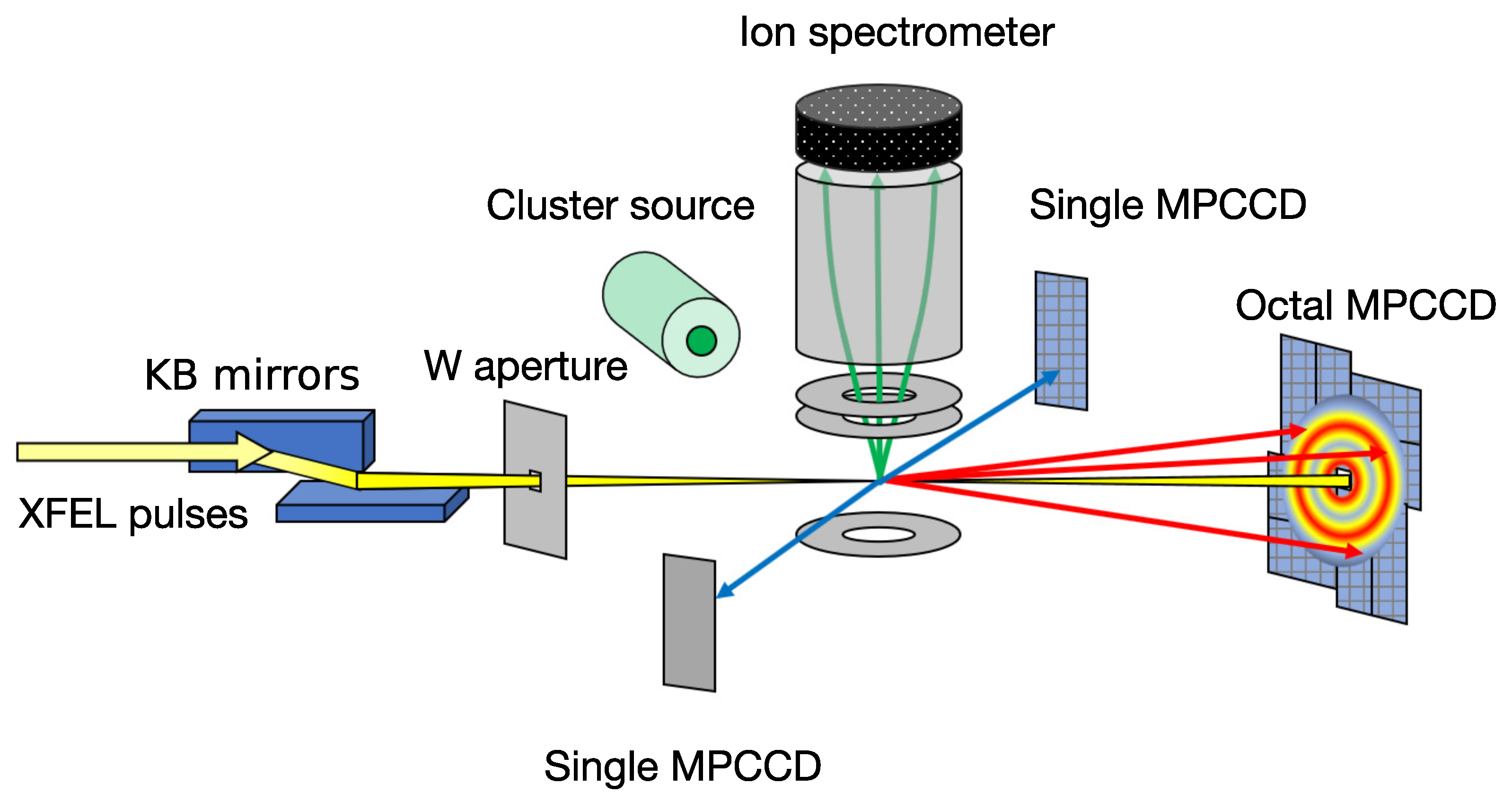
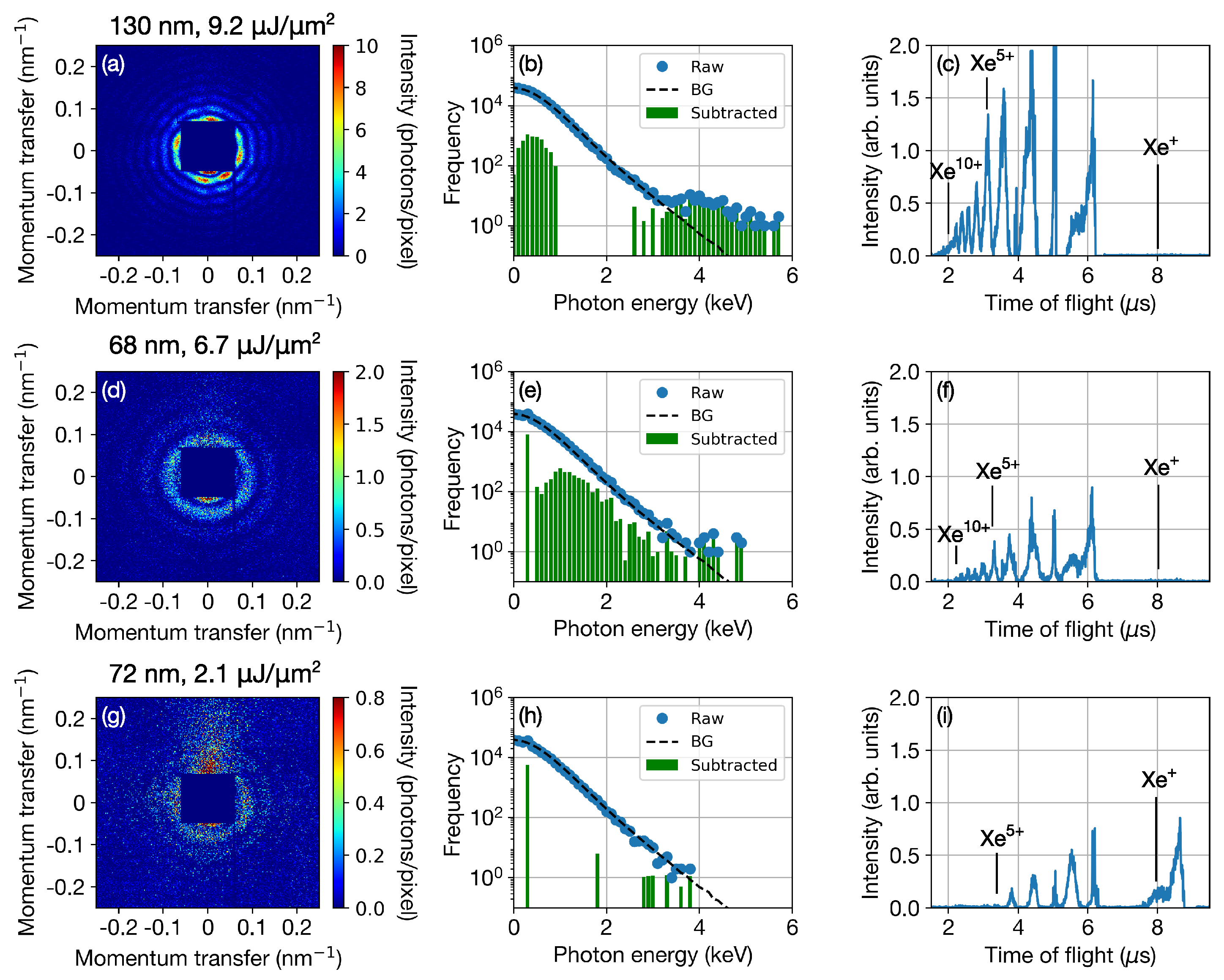
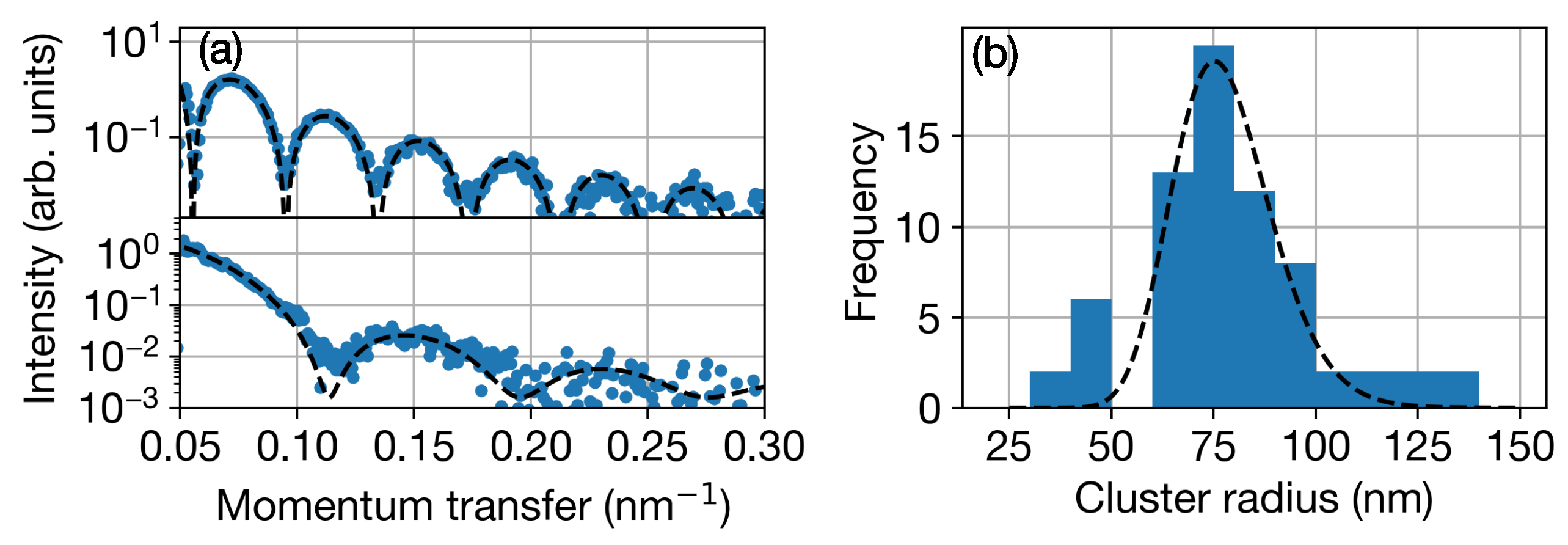
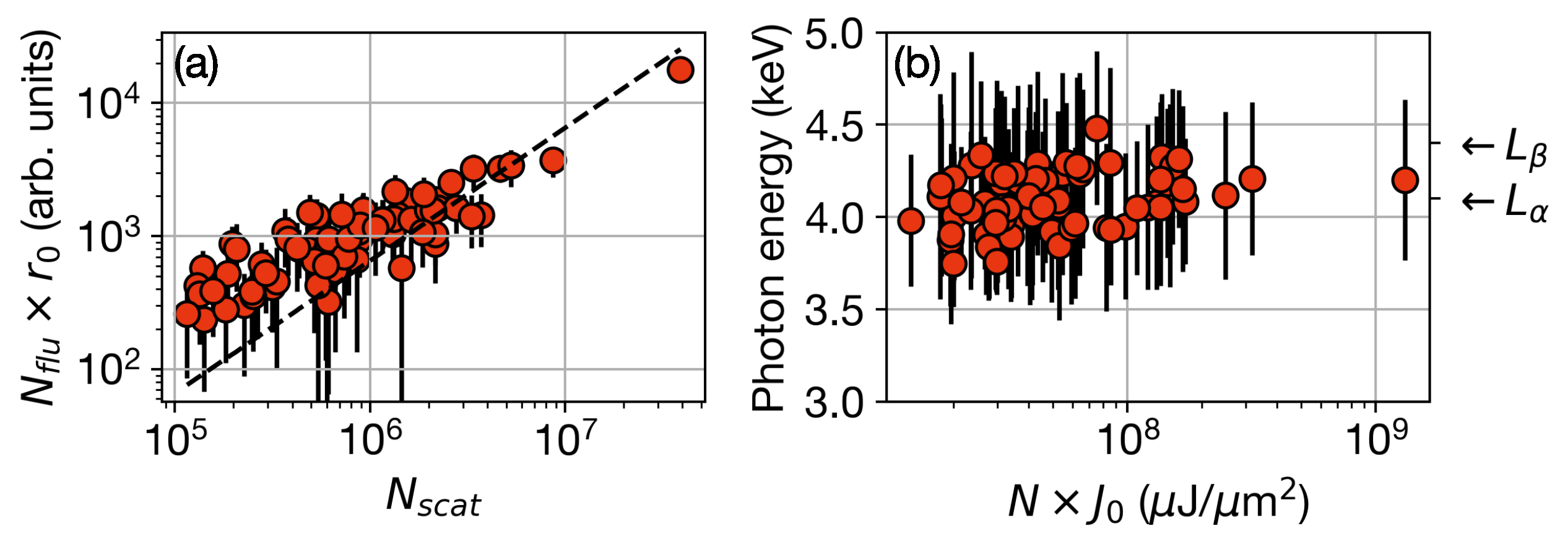
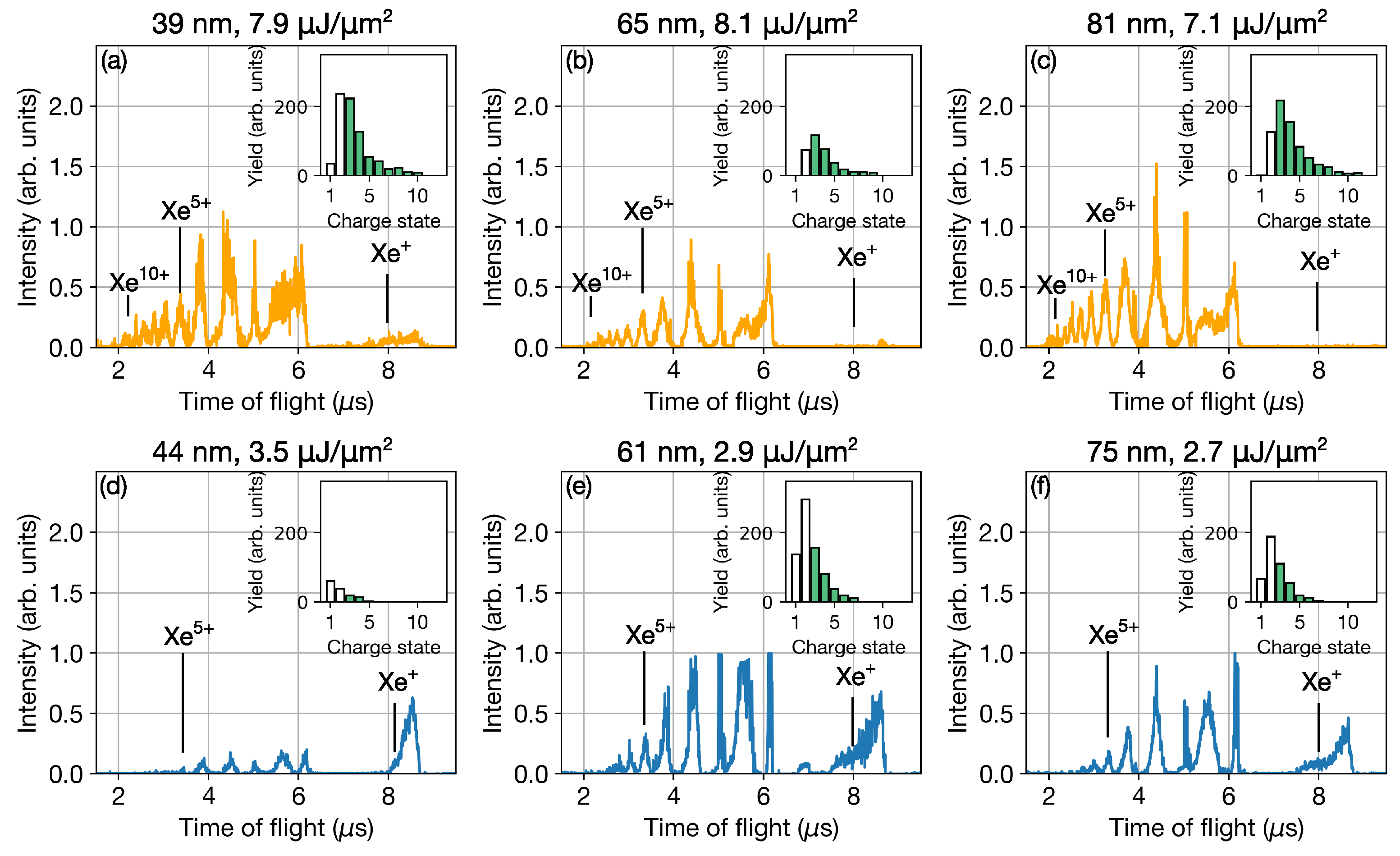
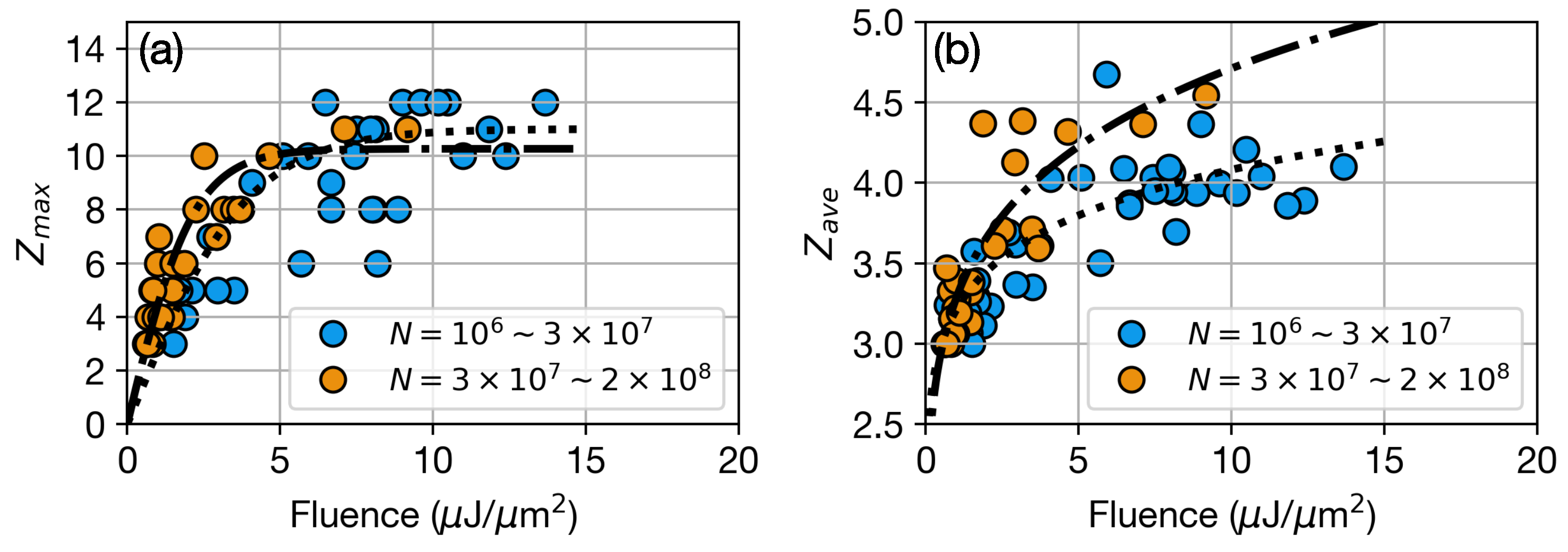
© 2019 by the authors. Licensee MDPI, Basel, Switzerland. This article is an open access article distributed under the terms and conditions of the Creative Commons Attribution (CC BY) license (http://creativecommons.org/licenses/by/4.0/).
Share and Cite
Nishiyama, T.; Bostedt, C.; Ferguson, K.R.; Hutchison, C.; Nagaya, K.; Fukuzawa, H.; Motomura, K.; Wada, S.-i.; Sakai, T.; Matsunami, K.; et al. Multispectroscopic Study of Single Xe Clusters Using XFEL Pulses. Appl. Sci. 2019, 9, 4932. https://doi.org/10.3390/app9224932
Nishiyama T, Bostedt C, Ferguson KR, Hutchison C, Nagaya K, Fukuzawa H, Motomura K, Wada S-i, Sakai T, Matsunami K, et al. Multispectroscopic Study of Single Xe Clusters Using XFEL Pulses. Applied Sciences. 2019; 9(22):4932. https://doi.org/10.3390/app9224932
Chicago/Turabian StyleNishiyama, Toshiyuki, Christoph Bostedt, Ken R. Ferguson, Christopher Hutchison, Kiyonobu Nagaya, Hironobu Fukuzawa, Koji Motomura, Shin-ichi Wada, Tsukasa Sakai, Kenji Matsunami, and et al. 2019. "Multispectroscopic Study of Single Xe Clusters Using XFEL Pulses" Applied Sciences 9, no. 22: 4932. https://doi.org/10.3390/app9224932
APA StyleNishiyama, T., Bostedt, C., Ferguson, K. R., Hutchison, C., Nagaya, K., Fukuzawa, H., Motomura, K., Wada, S.-i., Sakai, T., Matsunami, K., Matsuda, K., Tachibana, T., Ito, Y., Xu, W., Mondal, S., Umemoto, T., Miron, C., Nicolas, C., Kameshima, T., ... Ueda, K. (2019). Multispectroscopic Study of Single Xe Clusters Using XFEL Pulses. Applied Sciences, 9(22), 4932. https://doi.org/10.3390/app9224932






